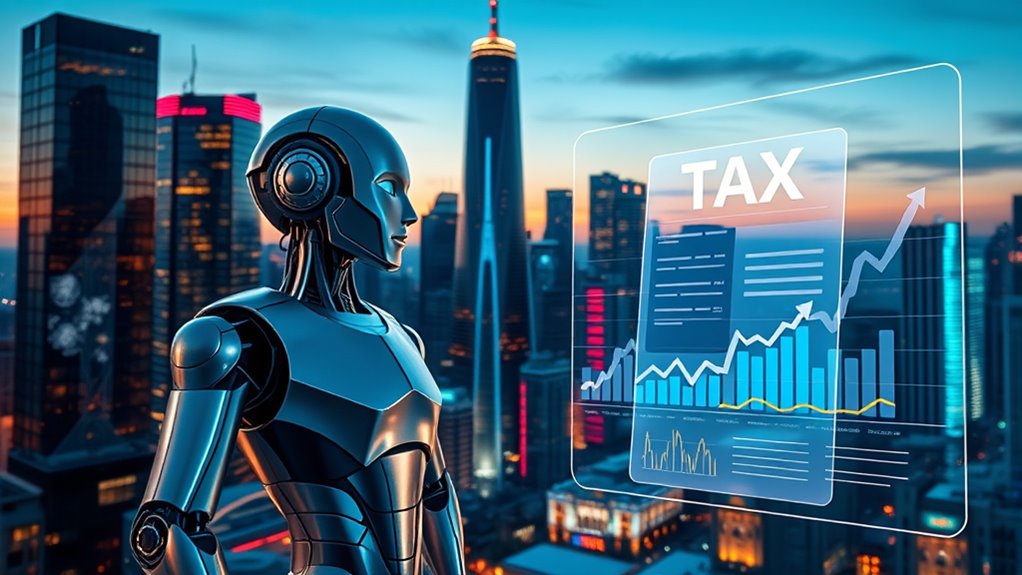Taxing robots might generate some revenue to support social programs and address economic shifts caused by automation, but it’s not a guaranteed or straightforward solution. Countries are exploring various approaches, and defining what counts as a “robot” can be tricky. While a modest tax could help fund retraining and reduce inequality, many challenges like enforcement, international coordination, and potential innovation slowdown remain. To understand if this idea really can secure our future, keep exploring the broader impacts and ongoing debates.
Key Takeaways
- Robot taxes could generate revenue to support social programs and mitigate economic disruptions caused by automation.
- Estimated robot tax rates (1-3.7%) may provide meaningful income without significantly hindering automation adoption.
- Implementing robot taxes helps offset lost labor tax revenue and address income inequality during automation-driven economic shifts.
- Challenges include defining robots, enforcing compliance, and preventing companies from offshore shifting or relocating to avoid taxes.
- Combining robot taxes with retraining programs and international cooperation enhances their effectiveness in funding a sustainable future.
The Rationale Behind Robot Taxes

The rationale behind robot taxes centers on addressing the financial and social impacts of automation. As robots replace human workers, your personal tax revenue declines because wages, which fund taxes, drop. Companies also pay less payroll tax when they replace employees with machines. To fill this gap, governments consider taxing robots, aiming to offset lost revenue from labor taxes. Since automation often boosts corporate profits taxed at lower rates, the tax seeks to balance the shifting income from workers to capital owners. Additionally, robot taxes can generate funds to support worker retraining, helping displaced employees transition into new roles. Implementing automation can further complicate tax collection and enforcement. Sound design techniques such as layered effects and digital synthesis can be used to create compelling auditory representations of automation’s impact. Research indicates that Ultimately, this approach aims to maintain public funding levels while adapting to technological progress and its economic consequences.
Global Approaches to Robot Taxation

Countries around the world are exploring different ways to tax robots, but there’s no consensus on how to define or implement such policies. South Korea’s approach, for example, focuses on specific automation sectors, reflecting broader international trends toward targeted, flexible tax models. As nations consider these strategies, coordination and clear standards become vital to prevent tax evasion and guarantee fair competition. Additionally, establishing regulatory frameworks can help ensure that robot taxation policies are effectively enforced and adaptable to technological advancements. Incorporating tax compliance measures that account for evolving automation technologies can further support transparent and fair taxation practices, especially considering the rapid pace of technological change in automation industries. Recognizing the importance of supermarket operating hours in retail settings demonstrates how operational flexibility can influence economic outcomes and policy implementation. Furthermore, understanding how sleep impacts cognitive function and mental health can inform policymakers on the broader societal implications of automation and labor shifts.
South Korea’s Robot Tax Model
South Korea stands out as the only nation to implement a form of robot tax, starting in 2017, by adjusting existing tax policies rather than creating a new direct tax on robots. The government reduced tax deductions for automation investments from about three to seven percent, increasing the tax burden on companies adopting robots. This approach aims to slow automation’s pace, preserve jobs, and recover lost income tax revenue from displaced workers. It also targets profits generated by robots within South Korea, preventing offshore shifting. The policy reflects concerns over unemployment and inequality amid rapid technological change. Here’s a snapshot of the impacts: Adding a new sentence The policy has prompted companies to reconsider their automation strategies, often leading to more cautious investment decisions. Here’s a snapshot of the impacts:
| Impact | Company Response | Social Effect |
|---|---|---|
| Reduced incentives | Slower automation adoption | Job security concerns |
| Increased tax burden | Short-term profit dip | Income inequality worries |
| Local profit taxation | Enhanced revenue collection | Fiscal stability |
Emerging Global Policy Trends
As automation and AI technologies rapidly expand across borders, policymakers worldwide are recognizing the need for coordinated approaches to robot taxation. They aim to address the economic shift from human labor to machines, tackling concerns over technological unemployment and shrinking tax bases. These policies seek to generate revenue to compensate for lost income taxes and encourage balanced automation, prompting firms to weigh costs carefully. Additionally, establishing clear signs of spoilage and proper storage methods can help prevent waste and ensure safety in food practices, which relates to broader issues of technological management and regulation. Moreover, insights from the 16PF questionnaire underscore the importance of understanding organizational dynamics and individual traits to effectively implement such policies. Understanding relationship dynamics can aid policymakers in designing more effective and adaptive regulations. Furthermore, the development of home furnishings that incorporate safety features, such as auto shut-off for electric heated mattress pads, exemplifies how technological advancements can be safely integrated into everyday life. Incorporating consumer preferences into product design can also enhance user safety and satisfaction. However, defining and enforcing robot taxes pose challenges, including tracking robotic work and avoiding discouragement of innovation. International cooperation becomes essential to prevent firms from relocating and to maintain competitiveness. Global efforts focus on establishing taxation models—such as revenue- or profit-based systems—and fostering dialogue among governments, industry, and international bodies to ensure fair, enforceable policies. Empirical data and forecasts show positive employment effects from automation, supporting the idea that well-designed policies can promote economic growth.
Automation’s Impact on Employment and Economy

Automation is displacing jobs faster than many expected, with nearly 14% of workers already affected. While AI boosts productivity and economic efficiency, it also creates challenges for employment and income stability. Current impact shows 14% of workers have experienced job displacement due to AI. Balancing these benefits and risks requires careful policy decisions to support workers and sustain economic growth.
Job Displacement Trends
Automation is rapidly transforming the job landscape, displacing millions of workers worldwide while simultaneously creating new opportunities. About 12.6% of the U.S. workforce faces high exposure to automation, and globally, 92 million jobs are expected to be displaced by 2030. Recent data shows 14% of workers experienced job loss due to automation or AI, with industries like energy, utilities, and mining at significant risk—nearly half of jobs could be automated by 2030. AI contributed to 5% of U.S. job losses in May 2023, and tech layoffs continue, driven by AI advancements. Despite these disruptions, the global economy is projected to generate 78 million new jobs between 2025 and 2030, with 170 million created through labor market shifts, emphasizing the need for skills adaptation. Automation displacement risk varies significantly within occupations, underscoring the importance of targeted workforce planning to address specific occupational vulnerabilities. Additionally, understanding AI integration in mobile devices can offer insights into how technological upgrades influence vehicle performance and efficiency, which parallels the importance of skill development in adapting to automation. Moreover, the impact of technological innovation on various sectors highlights the need for continuous learning and reskilling initiatives to prepare workers for future job markets. Recognizing technological advancements in vehicles like Audi tuning demonstrates how innovation can enhance performance and efficiency, mirroring the benefits of ongoing workforce adaptation. Furthermore, engaging with resources and tools, such as legal guidance or skill development programs, can be crucial in navigating these economic shifts effectively.
Economic Efficiency Gains
Automation and AI are transforming the global economy by considerably boosting productivity and profitability. They can increase global productivity growth by up to 3.4 percentage points annually and are projected to add around $15.7 trillion in economic value by 2023. By 2030, automation and AI are expected to drive 45% of total economic gains. Sectors like telecom and manufacturing see up to 40% increases in labor productivity and a 40% reduction in engineering costs, respectively. Automation also cuts operational expenses—RPA software costs about a third of offshore workers and one-fifth of onshore staff—and can reduce costs by up to 30% through hyperautomation. Overall, automation improves quality, customer satisfaction, and employee morale, while enabling organizations to operate more efficiently and stay competitive.
Policy and Workforce Balance
As automation and AI continue to reshape productivity and profitability across industries, their impact on employment becomes increasingly significant. You should be aware that 14% of workers have experienced job displacement due to automation or AI, with the tech sector seeing its largest layoffs since 2001—136,831 this year. While 58% of employers see automation as transformative by 2030, nearly half of workers suspect AI could threaten their jobs. Governments are exploring policies like automation taxes and retraining programs to address these shifts. Bridging automation’s benefits with employment stability involves fostering new job creation, emphasizing skills like problem-solving and empathy, and supporting workers through education and economic policies. This ongoing policy debate aims to guarantee a fair transition amidst rapid technological change. Recognizing the importance of ethical considerations in AI deployment can help ensure that technological progress benefits society as a whole. Additionally, understanding the employment landscape and how it evolves with automation is crucial for developing effective policies.
Practical Challenges in Implementing Robot Taxes

Implementing a robot tax presents several practical hurdles that policymakers and businesses must navigate. First, defining what counts as a “robot” is complex, leading to legal ambiguities and potential disputes. You’ll also face implementation challenges, as monitoring and auditing systems would be costly and intricate to manage. Internationally, differing policies can hurt competitiveness, especially for businesses operating across borders. Small and medium-sized enterprises might be disproportionately impacted due to limited resources, risking their viability. Additionally, a robot tax could disincentivize automation, slowing innovation and productivity growth. Developing consistent global standards and regulatory frameworks adds more difficulty, as jurisdictions vary widely. These practical issues could hinder effective enforcement and lead to unintended economic consequences.
Financial Benefits and Funding Opportunities

Taxing robots offers a clear path to generate revenue that can support social programs and ease economic shifts caused by automation. This income can help fund worker retraining, unemployment benefits, or education initiatives, ensuring society adapts more smoothly. By leveraging these funds wisely, you can address inequality while maintaining the benefits of technological progress.
Revenue Generation Potential
Could robot taxes become a meaningful source of public revenue? Potential estimates suggest that rates between 1% and 3.7% of a robot’s value could generate revenue without hindering adoption. Here’s what that means for you:
- Even at 1%, widespread robot deployment could produce significant income.
- These modest rates can complement existing corporate and income taxes.
- As robot saturation increases, tax rates might be reduced over time.
- Robot taxes could serve as a new, albeit limited, revenue stream similar to capital and trade taxes.
While empirical evidence is limited and mixed, studies show a positive correlation between robot use and higher corporate taxes in some countries. Overall, moderate robot taxes could contribute to funding public needs without severely impacting innovation.
Funding for Social Programs
As discussions around robot taxes gain traction as a potential new revenue source, it’s important to contemplate how existing funding mechanisms support essential social programs. Currently, Social Security benefits are projected to grow by $76 billion over 2025–2034, driven by an aging population, with SSI payments reaching around $46.56 billion in FY 2025. Nearly 7.4 million people rely on SSI, and the Social Security Trust Funds receive $15 billion annually. Nutrition programs like SNAP and child meals are also set to increase by $52 billion and $28 billion respectively, reflecting rising enrollment. Funding primarily comes from federal taxes, government borrowing, and mandatory spending. Expanding social programs requires sustainable sources, making efficient use of existing revenue crucial to maintain these vital supports.
Potential Risks to Innovation and Competitiveness

Imposing a robot tax risks hindering innovation by making companies less likely to invest in new technologies. This can slow economic growth and reduce technological progress. Here are four key concerns:
- It could decrease incentives for companies to develop and implement advanced automation.
- Slower innovation diffusion might result from a workforce lacking necessary skills for new technologies.
- Limiting automation could hinder the creation of higher-value products and services, stalling productivity growth.
- Increased operational costs may weaken the global competitiveness of U.S. companies, impacting their ability to innovate and grow.
Social Equity and Redistribution Effects

Implementing a robot tax aims to promote social equity by redistributing the economic gains from automation to support workers who face displacement. You’ll see funds directed toward public services like education, retraining, and social welfare, helping to bridge income and wealth gaps. This approach addresses the adverse effects of technological displacement on vulnerable groups, ensuring society benefits more evenly from automation’s productivity. Initially, robot taxes may reduce income inequality during rapid automation phases, shifting income toward routine workers. Revenue from a modest tax—around 0.6%—can fund retraining and social safety nets, mitigating inequality. While not as effective as direct income tax reforms, a robot tax complements other redistributive tools, fostering fairer economic outcomes and supporting social cohesion amid technological change.
Future Trends and International Cooperation

Future trends in robot taxation are shaping a global debate driven by rapid technological advancements and concerns over economic inequality. You should watch how countries respond to automation’s impact on economies and social fairness. Here are key developments:
- Countries are engaging in global debates to address automation’s effects, seeking coordinated approaches.
- The October 2021 international tax reform agreement shows efforts to align policies among nations.
- Nations like the U.S. are expected to lead international cooperation, fostering enforceable agreements.
- The EU is exploring whether robots could be classified as taxable entities under existing laws.
These trends highlight the importance of cooperation to prevent competitive disadvantages and ensure fair, effective taxation amid rapid technological change.
Designing Effective and Fair Robot Tax Policies

Designing effective and fair robot tax policies requires clearly defining which types of automation and AI functions should be taxed. You need to identify specific industries and functions to target, recognizing that not all automation is equal. Differentiating between industrial robots, AI systems, and embedded automation ensures precise policy application. Setting clear criteria for what constitutes a taxable robot prevents ambiguity and helps enforce rules effectively. You also must clarify whether the tax applies during manufacturing, import, or when robots are employed. Deciding whether only physical robots or also software-driven automation are included shapes the tax base. These decisions must align with existing legal frameworks, avoid loopholes, and guarantee the policy remains fair, balanced, and enforceable across different jurisdictions.
Balancing Technological Progress With Social Support

As automation and AI drive unprecedented economic growth and productivity, they also reshape the social fabric in complex ways. You need to balance progress with social support to guarantee everyone benefits. Here are key considerations:
- Invest in digital infrastructure to bridge the digital divide, giving underserved populations better access to education and employment.
- Develop retraining programs to help workers displaced by automation transition into high-skilled roles.
- Support social enterprises and innovative community initiatives that strengthen resilience and address inequality.
- Update social safety nets, like welfare and unemployment systems, to adapt to a changing job landscape.
Frequently Asked Questions
How Do We Define a “Robot” for Taxation Purposes?
You need to understand that defining a “robot” for taxation is complex. You should consider factors like autonomy, interconnectivity, physical presence, and whether it can act independently. You also face challenges like the lack of a universal definition and potential legal personhood. Careful criteria are essential to guarantee fair taxation, balancing technological capabilities with legal and ethical concerns, so that you can accurately categorize and tax these evolving entities.
Could Robot Taxes Hinder Technological Innovation and Economic Growth?
You might worry that robot taxes could slow down technological progress and hurt economic growth. When taxes increase on automation tools, businesses face higher costs, which discourages them from adopting new technologies. This slowdown reduces productivity, innovation, and competitiveness. As a result, your economy may grow more slowly, with fewer job creation opportunities and less income growth. So, implementing robot taxes could unintentionally stifle progress and limit overall economic development.
Who Would Be Responsible for Assessing and Collecting Robot Taxes?
You might think evaluating and collecting robot taxes fall on governments, and you’d be right. Tax authorities, like the IRS or HMRC, would oversee this process, likely relying on existing systems for income or corporate taxes. They’d need to develop new definitions, rules, and monitoring methods—probably combining automation and human oversight—to guarantee compliance. International cooperation would be essential to prevent tax evasion and maintain consistency across borders.
Will Robot Taxes Be Sufficient to Fund Social Welfare Programs?
You might wonder if robot taxes can fully fund social welfare programs. While they can generate revenue to support initiatives like UBI, education, and public services, the amount may not be enough on its own. To guarantee adequate funding, you’ll need complementary policies. Relying solely on robot taxes might fall short, so combining them with other revenue sources and reforms will be essential for sustainable social welfare funding.
How Might Robot Taxes Impact Global Competitiveness Among Countries?
Imagine your country implements a robot tax, but a tech giant moves operations abroad to avoid it. You might see your country lose essential investment and innovation, falling behind in global competitiveness. Robots attract productivity, but taxing them could push companies elsewhere. Without international coordination, your nation risks economic decline, job losses, and reduced technological leadership, making it harder to keep up with countries that offer more favorable environments for automation.
Conclusion
In the end, trying to tax robots might feel like chasing a mirage, but it’s a bold move toward shaping our future. While it’s no magic wand, implementing thoughtful robot taxes could reveal massive funds to support workers and society. You get to be part of this revolutionary shift—balancing innovation with fairness. So, keep your eyes on the horizon, because this game-changing idea could redefine how we build a smarter, more equitable world for everyone.









